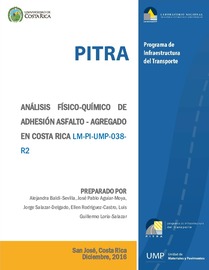ANÁLISIS FÍSICO-QUÍMICO DE ADHESIÓN ASFALTO - AGREGADO EN COSTA RICA

Date
2016Author
Baldi Sevilla, Alejandra
Aguiar Moya, José Pablo
Salazar Delgado, Jorge
Rodríguez Castro, Ellen
Loría Salazar, Luis Guillermo
Metadata
Show full item recordAbstract
El daño por humedad es una de las fallas más importantes que deterioran al pavimento. Se ha reconocido que este tipo de daño responde al debilitamiento de la interacción entre el asfalto y el agregado (reducción de la adhesión) y al debilitamiento de las interacciones cohesivas en el asfalto, ambos por efecto del agua. Producto de ello, ocurre el desprendimiento del asfalto de la superficie del agregado (desnudamiento) y el desprendimiento de agregados de la superficie del pavimento (desmoronamiento). Desde esta perspectiva, el daño por humedad es el detonante de otros mecanismos de falla y podría resultar tan severo que provoque la pérdida total de la mezcla asfáltica. Sin embargo, existen otros factores que contribuyen al daño por humedad, tales como el diseño de mezcla (materiales seleccionados, contenido de vacíos y de asfalto), la producción y construcción de la misma, factores ambientales, entre otros. Por lo tanto, no es posible definir completamente el daño por humedad con base en mecanismos individuales tales como desnudamiento o desmoronamiento: es necesario desarrollar una visión integral del fenómeno. Por esta razón, la presente investigación busca abordar el proceso de daño por humedad desde la perspectiva fundamental (dada por la fisicoquímica de las superficies) hasta sus repercusiones a nivel mecánico. Con tal de alcanzar este objetivo, se contó con varias fuentes tanto de agregado como de asfalto, las cuales fueron caracterizadas en términos de energía superficial. Adicionalmente, con estos materiales se produjo mezcla asfáltica, cuyo desempeño mecánico fue evaluado en condiciones húmedas. Los resultados obtenidos permiten enlazar las propiedades de superficie de los materiales con su comportamiento real en presencia de agua, utilizando ciertos parámetros fisicoquímicos relacionados con la compatibilidad del asfalto y el agregado con el agua. Adicionalmente, se logró establecer una relación entre el proceso de adhesión (y de desplazamiento en presencia de agua) y la polaridad tanto del asfalto como del agregado. Moisture damage is one of the most severe failures in asphalt mixtures. This failure occurs due to the weakening of the adhesion between binder and aggregate and the weakening of the interactions within the binder (cohesion) by the effect of water. As consequence, processes such as stripping and raveling deteriorate the pavement structure. From this perspective, moisture damage is a catalyst for other failure modes and it might cause the total loss of the asphalt mixture. However, there are other factors contributing to moisture damage, such as mix design (selected materials, voids content, asphalt content), environmental conditions, among others. Therefore, it is not possible to relate moisture-induce damage to a single mechanism such as stripping or raveling, it is necessary to develop an integral perception of this phenomenon. In this sense, the objective of this study is to characterize moisture-induced damage from the fundamental properties of materials (given by their surface properties) to their mechanical performance. In order to achieve this goal, several binder and aggregate sources were characterized in terms of surface energy. Additionally, the mechanical performance of the resulting asphalt mixture was tested under humid conditions. The results obtained allowed relating the surface properties of binders and aggregates to their performance in the presence of water. The previous was possible by means of applying certain physicochemical parameters that characterize the compatibility of binder and aggregate to water. In addition, it was possible to relate the adhesion between binder and aggregate to their polarity.
Collections
- Informes [1102]
